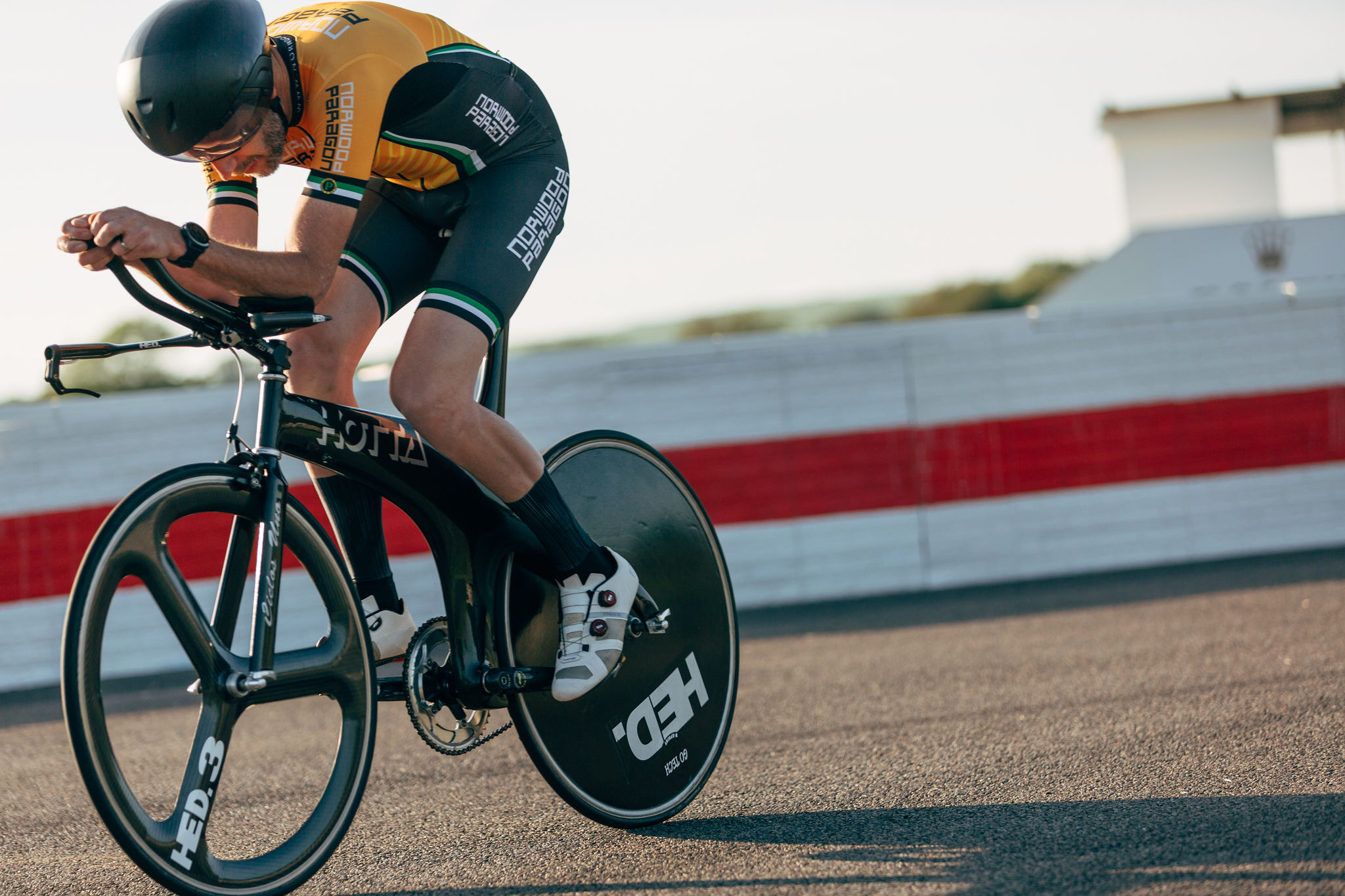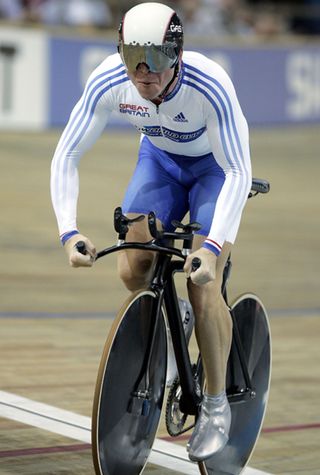Icons of cycling: UK Sports Institute track bike
We sing the praises of a machine that strikes fear into the hearts of Team GB’s rivals



The New Zealand rugby team perform the haka to intimate their opponents before an international. The Great Britain cycling team have no need of an ancestral war dance before a track meet.
A mere glimpse of the all-black UK Sports Institute track bike with its Darth Vader-like presence has the same effect.
In the gladiatorial arena of the velodrome, believing your bike is faster than the opposition’s — combined with the opposition believing it too — is the difference between gold and silver. And of course, in Team GB’s case, it actually is faster.
Since 2002, Team GB’s equipment has been the envy of the world, with the track frame the centrepiece in a collection of awe-inspiring custom components. The bike is now on MkII and is constantly being tweaked, but the blueprint remains the same.
The year after Jason Queally won gold in the kilo at the Sydney Olympics, the British Cycling Federation asked engineer Dimitris Katsanis to produce a new frame. Up to that point there had been no dedicated equipment programme.
Indeed, Chris Fields, the creator of the Hotta Perimeter that Queally used in Sydney freely admitted it had been designed in his garage.
Although this very British approach had famously borne fruit for Graeme Obree, now with lottery funding beginning to bolster its R&D budget and with Australian, American and German federations already having invested large sums in dedicated team bikes, it was time for Team GB to raise the bar.
Get The Leadout Newsletter
The latest race content, interviews, features, reviews and expert buying guides, direct to your inbox!
Katsanis studied composites engineering in Britain and had an array of carbon-fibre creations for national sport teams to his name when British Cycling called. He’d also been a national level track sprinter in his native Greece, so had an insight into the demands elite athletes made on their machines.
Record-breaking debut

The now-legendary matt-black frame he presented to Team GB wasn’t a radical shape — Katsanis had said he didn’t want to risk the UCI banning it — but it was fast.
Sir Chris Hoy immediately set new PBs on it and won gold at the 2002 Commonwealth Games kilo, where it was debuted.
Contrary to the conspiracy-minded mutterings from Team GB’s rivals, and despite the red herrings thrown in their path by Chris Boardman’s ‘Secret Squirrel Club’, there was no real secret to the UKSI bike.
Its tube profiles were simply as efficient as possible within the UCI’s parameters and it was made from better quality carbon-fibre than was commercially available at the time.
Its performance was improved yet further by the specially developed bars, stems, chainsets and skinsuits that accompanied it.

Thank you for reading 20 articles this month* Join now for unlimited access
Enjoy your first month for just £1 / $1 / €1
*Read 5 free articles per month without a subscription

Join now for unlimited access
Try first month for just £1 / $1 / €1
Simon Smythe is a hugely experienced cycling tech writer, who has been writing for Cycling Weekly since 2003. Until recently he was our senior tech writer. In his cycling career Simon has mostly focused on time trialling with a national medal, a few open wins and his club's 30-mile record in his palmares. These days he spends most of his time testing road bikes, or on a tandem doing the school run with his younger son.
-
 8 odd, quirky and cool tech innovations spotted at the Sea Otter Classic
8 odd, quirky and cool tech innovations spotted at the Sea Otter ClassicA kevlar wheel, an unusual aero bike, solid helmet straps, a bike made from recycled plastic bike, and more - 8 odd, quirky and cool tech innovations spotted at the Sea Otter Classic
By Daniel Palma Published
-
 Cycling training plans: 10 week plans for beginners, intermediates and racers
Cycling training plans: 10 week plans for beginners, intermediates and racersGet into cycling, get fitter, or ride faster with our cycling training plans
By Anna Marie Abram Published
-
 Laura Kenny, Britain’s most successful female Olympian, announces retirement
Laura Kenny, Britain’s most successful female Olympian, announces retirementKenny won five Olympic and seven world titles during her illustrious career on the track
By Tom Thewlis Published
-
 'I'm horrendously competitive': Get to know GB track sprinter Sophie Capewell
'I'm horrendously competitive': Get to know GB track sprinter Sophie CapewellOlympic hopeful tells Cycling Weekly about her cyclocross roots, wanting to be a scientist, and her proudest moment to date
By Tom Davidson Published
-
 Former Ineos Grenadiers boss Rod Ellingworth becomes race director of Tour of Britain
Former Ineos Grenadiers boss Rod Ellingworth becomes race director of Tour of Britain"I feel a real responsibility to get this right," says Ellingworth about new role
By Tom Davidson Published
-
 'We'll have rounder wheels than everyone else' - Team GB confident in new Olympics tech
'We'll have rounder wheels than everyone else' - Team GB confident in new Olympics techUpdated Hope-Lotus bike won't feature until Paris, confirms performance director Stephen Park
By Tom Davidson Published
-
 Jody Cundy Q&A: 'Strictly Come Dancing made me a stronger cyclist'
Jody Cundy Q&A: 'Strictly Come Dancing made me a stronger cyclist'The Paralympic legend tells Cycling Weekly about almost retiring in 2012, the time he borrowed a Porsche, and how dancing can make us all better cyclists
By Tom Davidson Published
-
 Zwift might be about to add a new map, leaked pictures suggest
Zwift might be about to add a new map, leaked pictures suggestZwifters might soon be able to compete in a virtual Omnium, or take on the Hour Record
By Tom Davidson Published
-
 ‘It’s a performance thing’ - why riders are eating Calippos and Greggs steak bakes to fuel gold medals
‘It’s a performance thing’ - why riders are eating Calippos and Greggs steak bakes to fuel gold medalsForget expensive gels, the best race nutrition comes from corner shops
By Tom Davidson Published
-
 Emily Bridges says British Cycling 'violated' her human rights over trans participation rule change
Emily Bridges says British Cycling 'violated' her human rights over trans participation rule changeNational federation blocked transgender riders from competing in its female event category last year
By Tom Thewlis Published